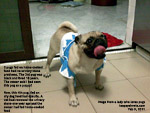|
Toa Payoh
Vets Clinical Research
Making veterinary surgery alive
to a veterinary student studying in Australia
using real case studies and pictures |
Recurrent struvite formation in the young pug
Dr
Sing Kong Yuen, BVMS (Glasgow), MRCVS
09 February, 2011 |
 toapayohvets.com toapayohvets.com
Be Kind To Pets
Veterinary Education
Project 2010-0129 |
FOR TOA PAYOH VETS VET REFERENCE BOOK FOR OWNER
EDUCATION
Case study: Infection-induced struvite uroliths in the dog
Pug, Male, 2 and half years.
Bladder stones removed by Vet 1 around one year ago. Dog was on Hill's SD on
one month, CD for 3 months. The complaint was dysuria (straining to
pee) for the past few days.
"Why?" the lady who had kept 3 pugs to an old age, had no
urinary stone problems. The black pug lived up to 18 years of age. (3
pugs were fed home-cooked food by the mother but this 4th pug was
given dry dog food as her mother had passed away.
However, she anticipated no problem after bladder stone
removal by Vet 1. "Why did the vet not advise follow-up? I stopped
giving the Hills' Prescription diet as my dog was showing allergy and
feed home-cooked rice and meat." Her father asked
me at another visit: "Is it because the vet (Vet 1) had not completely removed
all urinary stones?" Residual stones could cause a
recurrence but stones do recur even after complete stone removal.
 A
real case will interest the vet student as it can be sleep-inducing to
read through the several hundreds of pages of urinary stones in dogs
in various text books and the internet. The following case will help
to explain to students the approach to one approach to the medical
treatment of struvite uroliths in the dogs at Toa Payoh Vets. A
real case will interest the vet student as it can be sleep-inducing to
read through the several hundreds of pages of urinary stones in dogs
in various text books and the internet. The following case will help
to explain to students the approach to one approach to the medical
treatment of struvite uroliths in the dogs at Toa Payoh Vets.
There are 3 scenarios mentioned in the above website.
1. Medical dissolution of struvite uroliths in dogs
2. Prevention of infection-induced struvite uroliths
3. Prevention of sterile struvite uroliths in dogs
This pug has 1 and 2 and so the medical treatment (as
contrasted to surgical treatment) is
discussed below.
On 26.1.11, the pug strained to pass urine.
|
Urine Test results from lab: |
Urine: amber & turbid
pH= 8.0 (5-8)
SG = 1.010 (1.005 - 1.030)
|
Bilirubin ++
Blood ++++
WBC 0
RBC 8
Casts Nil
Bacteria ++ |
Crystals
triple phosphate +,
calcium oxalate occasional, amorphous phosphate ++
|
|
Calcium oxalate crystalluria.
Collect fresh urine and analyse within 30 minutes. If persistent
and in breeds (Bichon Frise, Miniature Schnauzer, Yorkshire
Terrier, Shih Tzu, Lhasa Apso), discontinue diets that promote
formation of acidic urine and consult recommendations for
Calcium oxalate prevention. |
Struvite crystalluria
is insignificant if the dog has negative urine
cultures. However this pug had bacteria in the urine.
Struvite is also known as triple-phosphate, ammonium phosphate and
urease stones and are invariably associated with urinary tract
infections in people and dogs with alkaline urine (pH > 7.2). |
|
Blood Test results from the lab: |
|
|
% |
Absolute |
|
WBC normal range. Biochemistry normal |
|
Neutrophils 71%
Lymphocytes 18%
Monocytes 9%
Eosinophils 0.2%
Basophils 1.8%
|
11.50
2.9
1.42
0.03
0.29
|
X-ray
No obvious urinary stones seen in the kidney, bladder or os penis. |
The alkaline pH, bacteria in the urine and struvite crystals
indicated a recurrence of the urinary stone formation with urinary
tract infection. The Owner wants medical (conservative) treatment. Acidifying tablets* (1 tablet 1 x/day for 10 days),
canned CD diet and trimethoprim antibiotics were prescribed.
*1 tablet/5 kg twice a day is recommended by manufacturer. The pug is
9.5 kg and would be getting 2 tablets 2x/day in theory.
|
|
Feb 7, 2011.
Owner is in her 30s and has good medical knowledge as she works
in the medical profession. She probably does internet research
on urinary stones in the dogs. She e-mailed to me the follow
dipstick result I had asked her to do at home.
Feb 7, 2011
Greetings Dr Sing
Happy New Year to you, your family and your folks at Toa
Payoh Vets! I had done a urine dipstix for XXX and results are as
follows:
Leukocytes: Neg
Nitrate: Neg
Urobilinogen: 0.2 |
Protein: Neg
pH: 5.0-6.0
Blood: Neg |
Ketone: Neg
Bilirubin: Neg
Glucose: Neg |
He's so much better with his urination though at times, his
post void can be slightly delayed (meaning he puts his leg
down quite some time even when there seems to be no more
urine).
As I will be leaving for overseas for a week on Wed
morning, do you need me to bring XXX over tomorrow?
Thanks and regards |
The urine was not alkaline as on
the first day of consultation. pH was 8.0 then.
Dipstick results are not reliable but is easy for the owner to
do. I advised a review of dog, urine bacterial culture and test
3-4 weeks after the first visit and get a urine test done
(via catherisation since it is difficult for the owner to
collect a mid-stream urine into the urine collection container!
The pug would stop peeing when she tried to collect urine.)
On Feb 8, 2011, the lady
owner came for acidurin tablets for another 20 days and said that
since the dog does not have much difficulty in urination, the trimethoprim tablets must be effective and therefore there is no
need for a urine antibiotic-sensistivity test.
PREVENTION OF
INFECTION-INDUCED STRUVITE UROLITHS
1. Treatment: Control urinary tract infections. Select
antibiotics based on urine bacterial culture and susceptibility
results. Culture urine during therapy to verify
effectiveness of antibiotics.
With additional recurrent infections, antibiotics for 4
weeks, then 1/2 daily doses for 9-12 months, 4-weekly urine
cultures.
2. Acidify urine: medication
3. Diet which promotes acidic urine. These have reduced protein,
phosphorus and magnesium.
4. Monitoring: Urine culture and urinalysis in 1 month and
3-monthly.
5. X-ray: Every 6 months or sooner if the patient has recurrent
urinary tract infection symptoms*.
*excessive vulval licking, urinating in the house, pollakiuria,
haematuria etc.
*identify and eradicate anatomic abnormalities (vaginourethrocystoscopy,
contrast vaaginourethrocystography and ultrasonography) and
functional (urine cortisol to creatinine ratio, serum
biochemical and thyroid profiles and neurological exam) risk
factors for recurrent infections.
Note 1: struvite crystalluria is insignificant if
the dog has negative urine cultures. However this case has
bacteria in the urine.
Note 2: Calcium oxalate crystalluria. Collect
fresh urine and analyse within 30 minutes. If persistent and in
breeds (Bichon Frise, Miniature Schnauzer, Yorkshire Terrier,
Shih Tzu, Lhasa Apso), discontinue diets that promote formation
of acidic urine and consult recommendations for Calcium oxalate
prevention.
An American veterinary school (webpage not available to the
members of the public) that does urolith analysis for Hills'
samples,
recorded that medical dissolution of struvite uroliths with
Hills' s/d canine was 100% effective after 3-6 weeks for sterile
struvite uroliths and 8-12 weeks with effective antibiotics for
infection-induced struvite uroliths. It seems that this
institution favours medical treatment (i.e. no surgery to remove
stones).
Immature dogs should
not be given low protein s/d for a long term. However, a short-term use with
antibiotics has rapidly dissolved infection-induced struvite
uroliths in 9-12 days without adverse events.
Owner/patient compliance when feeding s/d is easily determined
with a urine SG (mean = 1.008+/-0.003) and pH (mean =6.2+/-0.7).
If no urine sample, serum urea nitrogen is a reliable marker
(mean 3.5+/- 2.4 mg/dl). The s/d diet is high in fat and high
fat is a risk factor for pancreatitis.
Female Miniature
Schnauzers and others with hyperadrenocortisicism risk
pancreatitiis and UTI that includes urease-producing
uropathogens. Respond by discontinuing s/d diet, maintain
hydration if vomiting/pancreatitis occur. Consider alternative
that also acidify urine eg. canned w/d Canine) to correct
both diseases. 26% of canine nephroliths are composed of
struvite. They can be dissolved medically as in bladder stones
but this takes a much longer time due to reduced kidney
function, reduced urine production and reduced nephrolith dwell
time in therapeutically undersaturated urine.
CONCLUSION.
Approaches to treatment. Medical or surgical treatment? For
large stones and urethral obstruction, I advise surgery to
remove all the stones after antibiotic treatment. Stones do
recur even after complete stone removal in some cases. Many
Singapore owners do not comply with medical treatment and the
follow-up reviews (urine tests 3-monthly, X-rays 6 monthly).
I presume it is due to economics and lack of time. Surgery
should be done only after effective antibiotic treatment
rather than immediately.
In this case, the pug drinks little but drinks more after going
outdoors for exercise. "Try adding some ice-cubes to the water,"
I said to the lady who loves pugs only. Regular urine monitoring
will be needed for the next 6 months and no dry dog food or dog
treats and biscuits must be given. The lady owner was satisfied
with the outcome that the pug was no longer taking a long time
to pee.
Urine-marking in male dogs may or may not lead to urinary tract
infections as the male dog with-holds urine to have sufficient
amount to mark the territory. The alpha male dog pees
until the last drop and even tries to pee when there is no more
urine in the bladder. Neutering the dog may help prevent
urinary tract infection. The lady owner was not keen on
neutering. |
|
 Stones
submitted for analysis in one
female golden retriever by Toa
Payoh Vets showed magnesium
ammonium phosphate (struvite) 95%
in the stone and 100% in the shell
with zero in the nidus and
surface. Calcium phosphate
carbonate was 5% inside the stone.
More case
studies, goto:
urinary tract problems in
dogs and cats Stones
submitted for analysis in one
female golden retriever by Toa
Payoh Vets showed magnesium
ammonium phosphate (struvite) 95%
in the stone and 100% in the shell
with zero in the nidus and
surface. Calcium phosphate
carbonate was 5% inside the stone.
More case
studies, goto:
urinary tract problems in
dogs and cats |
|
|
|
 BE KIND TO OLDER DOGS& CATS --- GET TUMOURS
REMOVED EARLY --- WHEN THEY ARE SMALLER. More case
studies, goto:
Cats or
Dogs BE KIND TO OLDER DOGS& CATS --- GET TUMOURS
REMOVED EARLY --- WHEN THEY ARE SMALLER. More case
studies, goto:
Cats or
Dogs |
|
|
To
make an appointment: e-mail
judy@toapayohvets.com
tel: +65 9668-6469, 6254-3326 |
 toapayohvets.com toapayohvets.com
Be Kind To Pets
Veterinary Education
Project 2010-0129 |
|
|
 Toa
Payoh Vets Toa
Payoh Vets
Clinical Research
|
|
|
Copyright ©
Asiahomes Internet
All rights reserved. Revised:February 09, 2011
Toa Payoh Vets |
|
 TOA
PAYOH VETS
TOA
PAYOH VETS TOA
PAYOH VETS
TOA
PAYOH VETS